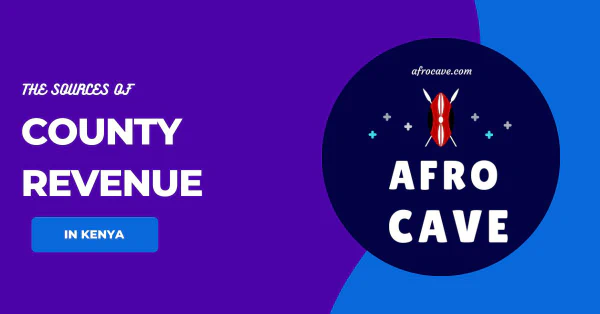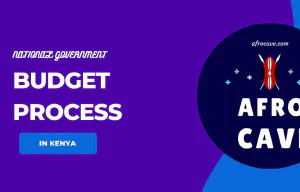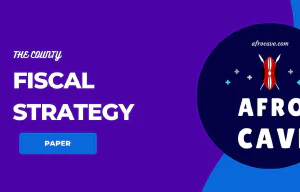Sources of Revenue for County Governments in Kenya
- Author Gĩthĩnji
- Updated on:

The sources of revenue for county governments in Kenya are diverse. The county governments require revenue to implement their functions. Schedule Four of the Constitution states these functions.
Therefore, it is important that the counties shall have adequate resources and sources of revenue to implement their functions.
Table of ContentsShow/Hide
sources of revenue for county governments
The sources of revenue for county governments in Kenya include revenue received from the national government, revenue generated locally, and revenue from external sources. Let’s explain the ways in which the county governments raise their revenue in detail below.
1. Equitable Share
The equitable share is the money parliament shares vertically between the national and the county governments. The money comes from the ordinary tax revenue the national government collects at the national level.
The Senate then allocates the equitable share for the counties (from the vertical share) horizontally among the 47 counties.
The equitable share is the biggest source of revenue for the county governments in Kenya.
The equitable share for the counties shall not be less than fifteen per cent of all the revenue raised by the national government. The most recent audited revenues (by the Auditor General) approved by parliament shall form the base for this threshold of 15 per cent.
The Senate uses a revenue-sharing formula developed by the Commission on Revenue Allocation (CRA) to divide the equitable share among the counties.
The equitable share allocated to the counties is unconditional. That is, the county governments can spend the money without any restrictions from the national government.
Funds given through the “equitable share” can be used in any legal way that the counties would like; there are no strings attached.
2. Own Source Revenue (OSR)
Article 209 (3) of the Kenyan Constitution empowers the county governments to impose two types of taxes and charges. These two sources of revenue for county governments in Kenya are property rates and entertainment taxes.
The county governments can also impose charges for any services they provide in accordance with the stipulated laws.
Some types of these own source revenue include (land) rates, single business permits, parking fees, building permits, and fees from billboards and advertisements.
The county governments impose their own source revenues through the Finance Act.
3. Conditional Grants
The county governments can receive additional allocations from the national government’s equitable share of revenue (from the vertical sharing). These additional allocations are known as conditional allocations or conditional grants.
They are conditional when the national government imposes restrictions on how county governments will spend them. They are unconditional when the national government does not impose any restrictions concerning their expenditure.
Most of these additional allocations are conditional allocations or grants. The county governments shall spend them on specific items in the budget. They cannot divert them for other purposes.
For example, if a county receives a conditional grant for level five hospitals, it shall not divert the money for other purposes other than these hospitals.
Conditional funds, at least in theory, are given for specific things with specific criteria for their use.
The conditional grants include the Equalization Fund that benefits certain areas that CRA recognizes and categorises as marginalised.
Other examples of conditional grants are money for Level Five hospitals (county referral hospitals), Compensation for user fees forgone (reimbursements for services county hospitals render) and Fuel Levy Fund (for maintaining county roads).
According to Dr Lakin, conditional grants may come with other conditions. For example, a conditional grant may require that a county also put in “matching” funds.
For instance, a county may receive a grant for 75 per cent of the cost of some service, such as a hospital, and be expected to put in 25 per cent on its own. If it refuses, it may not receive the grant.
It is also important to note that not all counties receive some conditional grants. For example, only the counties with level five hospitals receive the regional grant for level five hospitals. In addition, only those areas recognized as marginalised using CRA’s criteria receive the Equalization Fund.
4. Loans
Loans as sources of revenue for county governments in Kenya may come from external sources or private lenders.
The external sources include foreign lenders such as multinational corporations (IMF, World Bank, etc.). The private lenders include commercial banks and other financial institutions.
The County Governments can borrow or access loans, which they repay with interest. However, the counties must meet two conditions in order to access the loans.
First, they can only access a loan if the national government guarantees the loan. That is, the national government shall be willing to repay the loan if the county government is unable to repay.
Second, the County Assembly must approve any loans that the county government intends to borrow.
The Kenyan Constitution mandates Parliament to come up with legislation to prescribe how the national government shall guarantee loans.
The county governments shall not borrow beyond the limits set by the County Assembly.
5. Donor Funding
Donor funding as a source of revenue for county governments in Kenya involves aid from international donors or development partners.
International donors or development partners provide aid in the form of loans and grants.
As with the national government, the international donors can also request counties to put in ‘matching funds’ to receive a grant.
Such international donors include:
- United States Agency for International Development (USAID);
- Danish International Development Agency (DANIDA); and
- United Kingdom’s Department For International Development (DFID).
The donors or development partners can send the money directly to the counties. These funds are usually in the form of conditional grants. They can also send grants to the counties through the national government ministries, departments and agencies (MDAs).
In the latter case, the MDAs manage the grants but disburse the money to county governments to implement the grants.
Apart from ‘matching’ the funds, the donors or development partners may have other requirements for the counties to qualify to receive the grants.
For example, they may require the counties to increase accountability mechanisms or improve the capacity of county staff in monitoring and expenditure of donor aid.
6. Investments
This is a minor source of revenue for county governments in Kenya. Counties can receive returns or profits from undertaking investments (return on investments). That is, the counties can invest in some resources and the resulting returns or profits become revenue for the county government.
Therefore, it is important for the counties to compare the efficiency of different investments before investing and also after investing (and receiving returns) to maximise revenue from this source.
- «Previous The Budget Process for County Governments in Kenya
- Next» Role of Members of the County Assembly in Kenya


